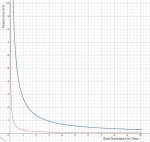Probably not, unless you're using a K100. Some of the most important things in a cloud competition are the build, the wicking, the airflow, and the battery. However, if these have been mastered there is still much more to be gained by analyzing the efficiency of your favorite mods. (And batteries!) It's hard to tell, with all the market hype these days, which mod REALLY kicks the most ass. It's even harder to tell, if you need a mod that kicks more ass than your trusty (insert favorite copper mod here). I've got the details, read on!
The term 'Voltage Drop' is an often misused term to describe how hard a mod is capable of hitting. It is actually an incredibly significant factor in achieving a high-powered, trophy winning vape. The battery is the main culprit when checking voltage drop, so for the purposes of the following tests, a DC power supply was used instead. To illustrate, here is a comparison between a typical stainless steel mod, and a typical copper mod.
A big difference, that may be obvious to some, but unnoticed by the guy still vaping his Protank II. When it comes to vaping at resistances above 1 ohm, you really can't go wrong. But for cloud seeding, every millivolt counts. With ohms law, we can isolate the most important thing you need to know about voltage drop: the actual resistance of the mod.
For those of you who continued reading after the math, I'll assume you have a basic understanding of electricity. When measuring the voltage drop of a mod, a voltage measurement alone means nothing. Only when it is combined with another measurement, such as current or resistance, is it a useful figure. Having the actual resistance measurement allows us to calculate how the mod will perform under just about any circumstance.
Let's use the resistance measurements in a realistic example. Say you have your Salt Creek mod and your Rig mod built with an identical 1 ohm coil. Add together the resistance of the mod and the coil, to get the actual 'load' resistance.
In the case of the Salt Creek Mod, about 2.7% of the 'Power' (measured in Watts) coming from the battery,
will be lost in the form of heat, by the mod.
In the case of the Rig, about 0.25% of the power coming from the battery will be lost. Neither of these figures are particularly significant. Let's see what happens when we vape on a semi-cloud chasing build of 0.1Ω:
Now we see the difference. The fact is: Power loss in the mod increases as your build resistance decreases.
Here is a graph showing the power efficiency of the Copper Rig (Red) Vs The Stainless S.C. Mod (Blue)

Here is the extent of the S.C. Mod's curve:

Conclusion:
By the graph we can see that the copper Rig mod is over 95% efficient at even the lowest of responsible coil builds. The Stainless Salt Creek mod was much different, wasting 10% of your battery's power on a 0.25Ω coil build. The choice is yours for your vaping style.
Notes: These test results are fairly standard. The majority of single 18650 copper mods will perform similarly to the copper Rig mod, and the majority of single 18650 stainless steel mods will perform similarly to the stainless Salt Creek mod. There are many exceptions for better and worse. The Tobecco Hammer clone was a severe case of voltage drop, where a copper mod I've recently tested was extremely good at 0.0005Ω.
Test Parameters:
Unfortunately the typical voltage drop test involving a cheap voltage meter between the mod and battery is horribly inaccurate. This is mostly the battery's fault. Due to internal resistance and non-linear voltage output, batteries are not an acceptable way to test the voltage drop of your mod.
*These figures were recorded while passing 50A current through the mod, with a 17x65mm insulated copper rod in place of the battery. Power supply was constant voltage DC around 5 volts, adjusted to achieve 50A on a current meter (accurate to +/-2.5%). Load was a 0.1Ω 300W resistor connected via 4x 12ga solid copper wires to a Dark Horse RDA deck. Voltage drop was measured from the center pin of the atomizer, to the upper cap of the mod. Measurements taken with DMM accurate to +/-1%. I was unable to measure the resistance of the atty's center pin itself, so it was included in the figures above. Also, the switches on these mods have no consistency. Depending on how hard or what angle you push the switch, the voltage drop varies drastically. These figures we some of the best that I was able to get.
Voltage Drop Is RealThe term 'Voltage Drop' is an often misused term to describe how hard a mod is capable of hitting. It is actually an incredibly significant factor in achieving a high-powered, trophy winning vape. The battery is the main culprit when checking voltage drop, so for the purposes of the following tests, a DC power supply was used instead. To illustrate, here is a comparison between a typical stainless steel mod, and a typical copper mod.
These mods were both tested at a measured current of 50 amps. Details near the end of this post.
Authentic Salt Creek Mod Co. (Stainless Steel):Voltage Drop: 1.3V-1.5V @ 50 Amps*
(Note: It became too hot to hold in about 5 seconds.)
(Note: It became too hot to hold in about 5 seconds.)
Authentic VAMP Rig Mod (All Clean Copper):
Voltage Drop: 0.10V - 0.15V @ 50 Amps*
(Note: Too hot to hold comfortably after about 30 minutes.)
(Note: Too hot to hold comfortably after about 30 minutes.)
A big difference, that may be obvious to some, but unnoticed by the guy still vaping his Protank II. When it comes to vaping at resistances above 1 ohm, you really can't go wrong. But for cloud seeding, every millivolt counts. With ohms law, we can isolate the most important thing you need to know about voltage drop: the actual resistance of the mod.
1.4 Volts ÷ 50 Amps gives us the approximate, actual resistance of the Salt Creek mod: 0.028Ω (0.028 Ohms)
0.125V ÷ 50A = 0.0025Ω for the copper Rig.
For those of you who continued reading after the math, I'll assume you have a basic understanding of electricity. When measuring the voltage drop of a mod, a voltage measurement alone means nothing. Only when it is combined with another measurement, such as current or resistance, is it a useful figure. Having the actual resistance measurement allows us to calculate how the mod will perform under just about any circumstance.
Let's use the resistance measurements in a realistic example. Say you have your Salt Creek mod and your Rig mod built with an identical 1 ohm coil. Add together the resistance of the mod and the coil, to get the actual 'load' resistance.
Salt Creek Mod: 0.028Ω + 1Ω coil = 1.028Ω Load
Rig Mod: 0.0025Ω + 1Ω coil = 1.0025Ω Load
Rig Mod: 0.0025Ω + 1Ω coil = 1.0025Ω Load
will be lost in the form of heat, by the mod.
For the Rig: 0.0025Ω ÷ 1.0025Ω = 0.0025 which is our percentage, 0.25%
In the case of the Rig, about 0.25% of the power coming from the battery will be lost. Neither of these figures are particularly significant. Let's see what happens when we vape on a semi-cloud chasing build of 0.1Ω:
Salt Creek Mod: 0.028Ω + 0.1Ω = 0.128Ω Load
Rig Mod: 0.0025Ω + 0.1Ω = 0.1025Ω Load
Works out to 21.9% Loss
Rig Mod: 0.0025Ω + 0.1Ω = 0.1025Ω Load
Works out to 2.4% Loss
Here is a graph showing the power efficiency of the Copper Rig (Red) Vs The Stainless S.C. Mod (Blue)

Here is the extent of the S.C. Mod's curve:

Conclusion:
By the graph we can see that the copper Rig mod is over 95% efficient at even the lowest of responsible coil builds. The Stainless Salt Creek mod was much different, wasting 10% of your battery's power on a 0.25Ω coil build. The choice is yours for your vaping style.
Notes: These test results are fairly standard. The majority of single 18650 copper mods will perform similarly to the copper Rig mod, and the majority of single 18650 stainless steel mods will perform similarly to the stainless Salt Creek mod. There are many exceptions for better and worse. The Tobecco Hammer clone was a severe case of voltage drop, where a copper mod I've recently tested was extremely good at 0.0005Ω.
Test Parameters:
Unfortunately the typical voltage drop test involving a cheap voltage meter between the mod and battery is horribly inaccurate. This is mostly the battery's fault. Due to internal resistance and non-linear voltage output, batteries are not an acceptable way to test the voltage drop of your mod.
*These figures were recorded while passing 50A current through the mod, with a 17x65mm insulated copper rod in place of the battery. Power supply was constant voltage DC around 5 volts, adjusted to achieve 50A on a current meter (accurate to +/-2.5%). Load was a 0.1Ω 300W resistor connected via 4x 12ga solid copper wires to a Dark Horse RDA deck. Voltage drop was measured from the center pin of the atomizer, to the upper cap of the mod. Measurements taken with DMM accurate to +/-1%. I was unable to measure the resistance of the atty's center pin itself, so it was included in the figures above. Also, the switches on these mods have no consistency. Depending on how hard or what angle you push the switch, the voltage drop varies drastically. These figures we some of the best that I was able to get.
